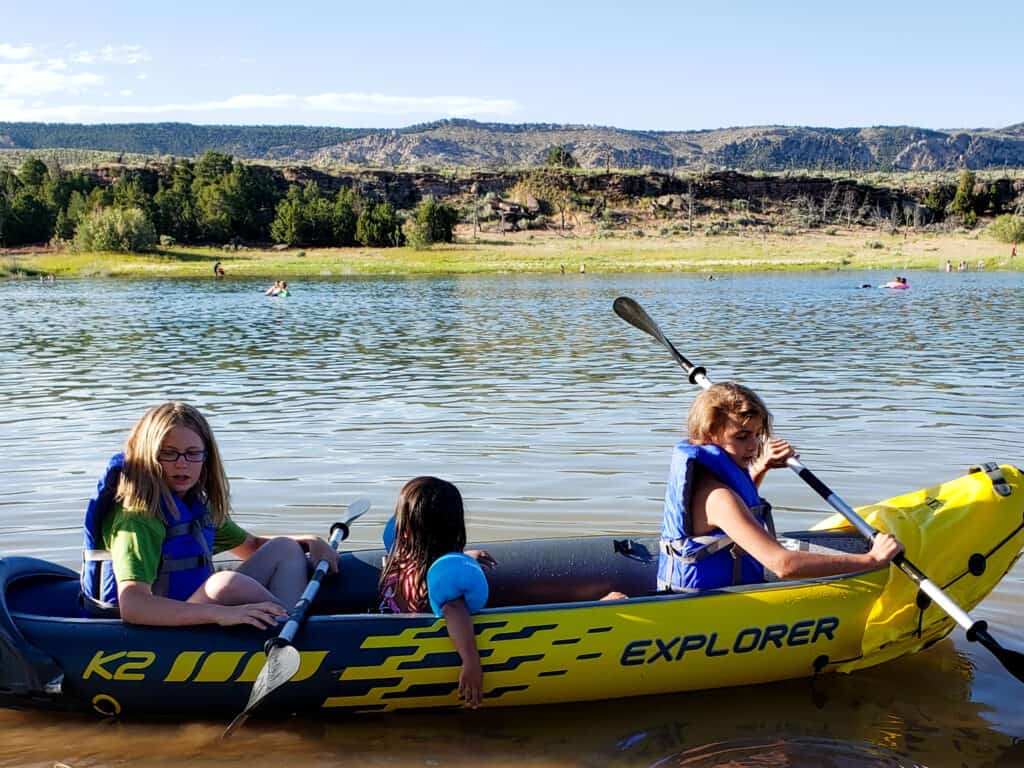
Kayaking with people who can’t swim well, like children, can be a scary prospect. We often wondered if we should leave our younger children home when we were paddling, but we found that they usually did well and enjoyed themselves.
Kayaking is generally a good activity for non-swimmers as long as basic rules are followed. Non-swimmers should not kayak alone, they should always wear a Coastguard approved lifejacket, and they should only kayak in safe conditions. When the non-swimmer is a child, it’s best if they tandem-kayak with an adult.
Here are the best things to do when paddling with non-swimmers.
Kayaking with Non-Swimmers
As long as the basic kayaking safety rules are followed, there’s no reason for non-swimmers not to go kayaking. Most importantly, all kayakers and canoeists should wear their life jackets at all times. Even when the conditions seem safe and the water is warm, a sudden spill can be unnerving enough to cause panic. For small children and children who are not expert swimmers, this is especially true. Even people who feel safe when swimming can panic when they are suddenly and unexpectedly tipped out of a kayak.
Adults who are paddling with non-swimmers should also keep their life jackets on. Helping a struggling, panicking child while trying to keep yourself above water is a challenge in the best of circumstances.

Practicing Near Shore
Before you go on your first paddling trip, practice with your kayaks near shore. This works best if it’s part of a swimming trip. Spend some time learning how to sit and paddle, and what part of the craft the kids feel comfortable sitting in. If you are in a canoe or open kayak, there will be several areas that they may be able to sit in and it’s a good idea to find out where they like hanging out.
Also practice climbing into the kayak or canoe from the water while you are playing. When kids are already wet and playing in the water, they won’t be as scared about falling out of a kayak. Climbing in and out is good practice and is harder than it looks. You don’t want to learn how to climb back in for the first time after you have taken a spill, and everyone is cold and scared.
If you can, also try climbing into the kayak yourself from water that is over your head. It is much harder than climbing in from shallow water and it’s good to know how to do it. Also practice helping your child back in from deep water (with your life jackets on, of course.)
Choosing a Safe Place to Paddle
Whether you are beginning kayaker or you are experienced, you need to find the right kind of place when you are paddling with a non-swimmer. You will want to choose an area with still water (or water with only a slight current). You don’t want to paddle in waves or windy weather, or in white-water conditions where you are more likely to tip your kayak, get soaked, or have a scared child.
You also don’t want to kayak in cold water. You can assume that you and your child will both get at least a little wet, and many times the water is much colder than the air. And if you do experience anything that goes wrong, remember that cold water takes an uncomfortable or annoying situation and makes it life-threatening very quickly. Water below 60 or 70 degrees can be shocking to the system and cause impaired thinking. It can even cause you to go into “cold shock” which is dangerous, especially for children.
Choosing a Life Jacket
When you are kayaking with kids, the most important thing you can choose (even more important than the kayak) is your life jackets. Here are some of the things you need to consider when purchasing a life jacket:
- Coastguard Approval
- Size
- Purpose
- Classification
- Comfort
Coastguard Approval: You need to know that the life jacket has been tested and that it works. This is what the Coastguard approval is for. Not all Coastguard approved jackets are designed for water rescue or water sports situations, so learn about the different certifications and designations.
Size: A life jacket that is too big or small will not work as it was designed. It is very important to only use life jackets that are sized properly and fit correctly when they are worn. This means that you will need to purchase new life jackets as your kids grow. Each season, as you get ready to begin paddling again, check your life jackets before you go out to make sure they’re still sized correctly and in good condition.
Purpose: Life jackets are designed for many different purposes, from emergencies at sea to water sports. For adults or older children, you want to look for a life jacket that is designed for water sports or paddling. For younger children, look for a vest that isn’t bulky, doesn’t hike up around their face when they are sitting, and will stay in place in the water.
Classification: Life jackets are classified according to their use. For kayaking with children, where you are not likely to experience long-lasting emergencies or extreme weather conditions, a regular flotation device such as a child’s life vest or watersport vest is usually sufficient.
Comfort: Look for life jackets that are comfortable while you are sitting for long periods, such as a paddling vest. These jackets are designed to be more comfortable while sitting for long periods and allow free use of the arms without rubbing. When you are buying a life jacket, try is on while moving around and sitting in different positions. Make sure that it isn’t too long- this will cause it to push up around your face when you sit down. Also practice leaning back in a seat, sitting on the floor, and making paddling motions. If your life jacket fits well and isn’t annoying, you are more likely to keep it on.

Conclusion
When you are ready to get out on the water with your young children, you will feel less nervous and have more fun if you stick to the basic safety rules and use your common sense.
- Always wear your life jacket
- Make sure someone knows where you are headed
- Only paddle in calm and safe conditions
- Avoid cold water
- Take a basic first aid kit
- Stick to one non-swimmer per adult
- Practice paddling in controlled circumstances

